However, as the 14-day required quarantine was lifted in February; all counties, including Bernalillo, move beyond the red phase; and the state’s vaccination rates lead the nation, New Mexico and Albuquerque are poised for a quick recovery and continued trajectory towards growth.
Total Doses Administered Reported to the CDC by State/Territory and for Select Federal Entities per 100,000 of the Total Population (as of April 7, 2021)
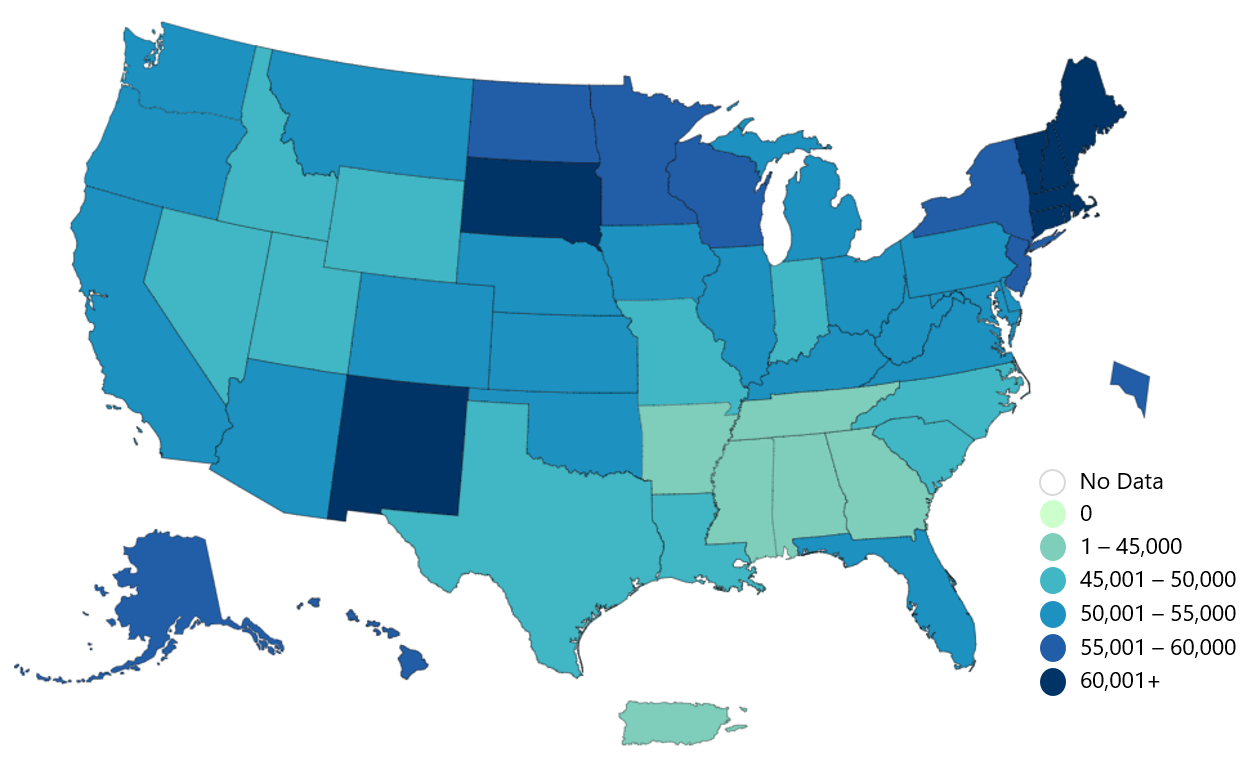
Doses Administered by County (as of April 7, 2021)
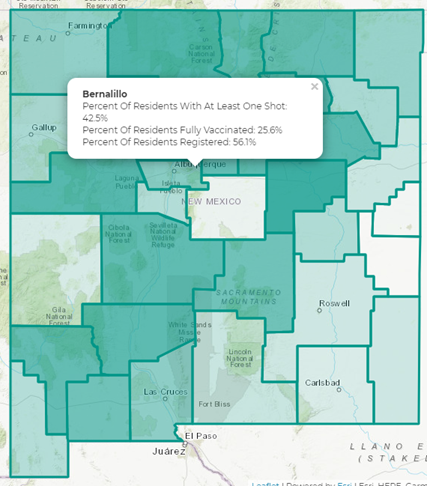
Covid Restrictions
Since mid-March, the region has been affected by the COVID-19 pandemic and resulting travel and business-operation restrictions. Although some restrictions and "stay at home" orders were lifted in late May and early June, a number of these restrictions, such as for indoor dining at restaurants and bars, were reenacted on July 13. Additionally, the 14-day quarantine for travelers arriving by air was extended to all travelers regardless of transportation means (subject to some exceptions) on July 1, 2020, significantly limiting out-of-state tourism; the required quarantine was lifted on February 10, 2021. From March through the end of August, occupancy limits ranged from 25% to 50% for hotels, excluding essential workers, extended-stay guests, and other categories. On August 29, 2020, restaurants and retail outlets were allowed to reopen with strict social-distancing guidelines and occupancy restrictions in place. Hotel occupancy was allowed to increase to 75% with the New Mexico Safe Certified training and 50% without until mid-November, when a two-week shutdown began. All non-essential businesses were closed and only hotels with NM Safe Certified training were allowed to operate at 25% occupancy. The shutdown ended November 30.
As of December, the reopening approach has been evaluated on a per-county basis, determining reopening based upon the trending of COVID-19 cases. The four stages, from most severe to least severe, are the red phase, yellow phase, green phase, and turquoise phase (added February 24). In the red phase, essential retail spaces are limited to the lesser of 25% occupancy or 75 people, restaurants are limited to 25% occupancy outdoors, hotels are limited to 40% occupancy with safety training, and groups are limited to five people. In yellow phase, hotel occupancy increases to 60% with safety training and groups of up to ten are allowed, while in the green phase, the group size limit increases to 20 and hotel occupancy with safety training increases to 75%. In the turquoise phase, hotels with safety training can operate with no occupancy limit, and the group limit increases to 150 people.
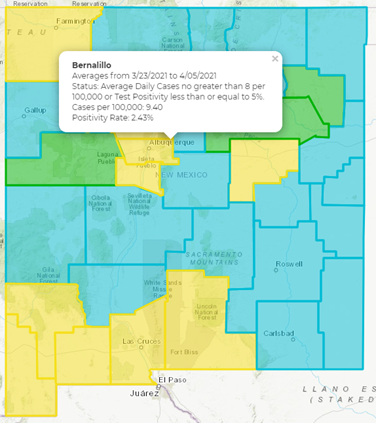
Albuquerque Market Overview
- Albuquerque is the largest city in the state of New Mexico and is the seat of Bernalillo County. The city is situated in the central part of the state, straddling the Rio Grande, at the intersection of Interstate 25 and Interstate 40. Albuquerque is home to the University of New Mexico (UNM), Kirtland Air Force Base, the Sandia National Laboratories, numerous related contracting companies, and a growing film-production industry. Many of the government or military entities and related contractors have remained a source of demand throughout the pandemic.
- The healthcare sector is supported by Blue Cross Blue Shield, as well as numerous hospitals and the UNM Health Sciences Center. UNM has begun a hospital expansion; construction of a $95-million, 1,400-space parking structure commenced in January 2021, while construction of the hospital tower, an investment in excess of $500 million, will begin in the summer of 2021 and be completed in 2024. This project is expected to add 96 critical-care beds.[1]
- Facebook opened a $1-billion data center in Los Lunas in 2019. The center currently includes four operational buildings and two more under construction, according to Albuquerque Economic Development (AED). However, a plan to double the size of the center and the number of permanent jobs was approved by the Los Lunas Village Council on March 11, 2021; the request includes $6,666,666,667 of funding through bonds for six additional data centers.[2] Beyond the hundreds of construction and permanent jobs, this center has also created hundreds of jobs in the renewable energy sector in nearby Torrance County through the construction and operation of wind farms and transmission lines, according to the Estancia Valley Economic Development Association (EVEDA).
- Prior to the pandemic, economic growth within Albuquerque was supported by the increase in film production given the incentives offered by the state, as well as Netflix and NBCUniversal announcing in 2018 and 2019, respectively, that Albuquerque will serve as a hub for production. In late 2020, Netflix announced a proposed expansion of 300 acres near its existing studios in the Mesa Del Sol area. Construction would include ten additional stages, offices, and other supporting facilities that would create roughly 2,500 jobs (1,000 permanent over in the next ten years and 1,467 construction jobs) and an additional investment of up to $1 billion over the next decade, beyond the initial $1-billion commitment.[3] This pillar of the economy continued to generate hotel demand during 2020 and is expected to support the recovery going forward.
- Beyond Kirtland Air Force Base and the Albuquerque International Sunport, several projects near the airport bode well for the airport submarket.
- The Orion Center, proposed by Theia Group, was approved in late 2020 and includes a two-million-square-foot light-manufacturing building and a 1.3-million-square-foot office and engineering building. Additional commercial support buildings are also proposed on the 120-acre site, and the first phases are expected to be completed in 2023. However, final funding, leases, and other components are still underway. If the project moves forward, it could create 2,500 jobs.[4]
- The United States Air Force awarded Thunderbird Kirtland Development LLC a contract for a 77-acre site on Kirtland Air Force Base, which was officially leased in November 2020. Upon completion, the development, named Max Q at Kirtland, will reportedly include office and retail space, restaurants, and a hotel. The project is expected to break ground in the second quarter of 2021, following the execution of tenant leases, and the first phase could be completed in the summer of 2022.[5]
- Several major events, such as the Gathering of Nations Powwow (typically held in April) and Albuquerque International Balloon Fiesta (first two weeks in October), were held virtually or canceled in 2020. The loss of these events had a notable impact on the hospitality industry. For instance, hotel revenue during the typical Balloon Fiesta weekends was down almost 75% when compared to the event period in 2019. According to Albuquerque International Balloon Fiesta, Inc., the Balloon Fiesta attracted 860,000 visitors in 2019 with an economic impact greater than $180 million.[6] While the Gathering of Nations Powwow will be held virtually in 2021, the Albuquerque International Balloon Fiesta is expected to occur in person in 2021.
- Furthermore, the loss of events at the convention center, area hotels, and sporting venues due to stringent group restrictions associated with the COVID-19 pandemic have limited demand through Q1 2021. The following charts from Visit Albuquerque outline the loss of room nights from conventions and events during 2020.
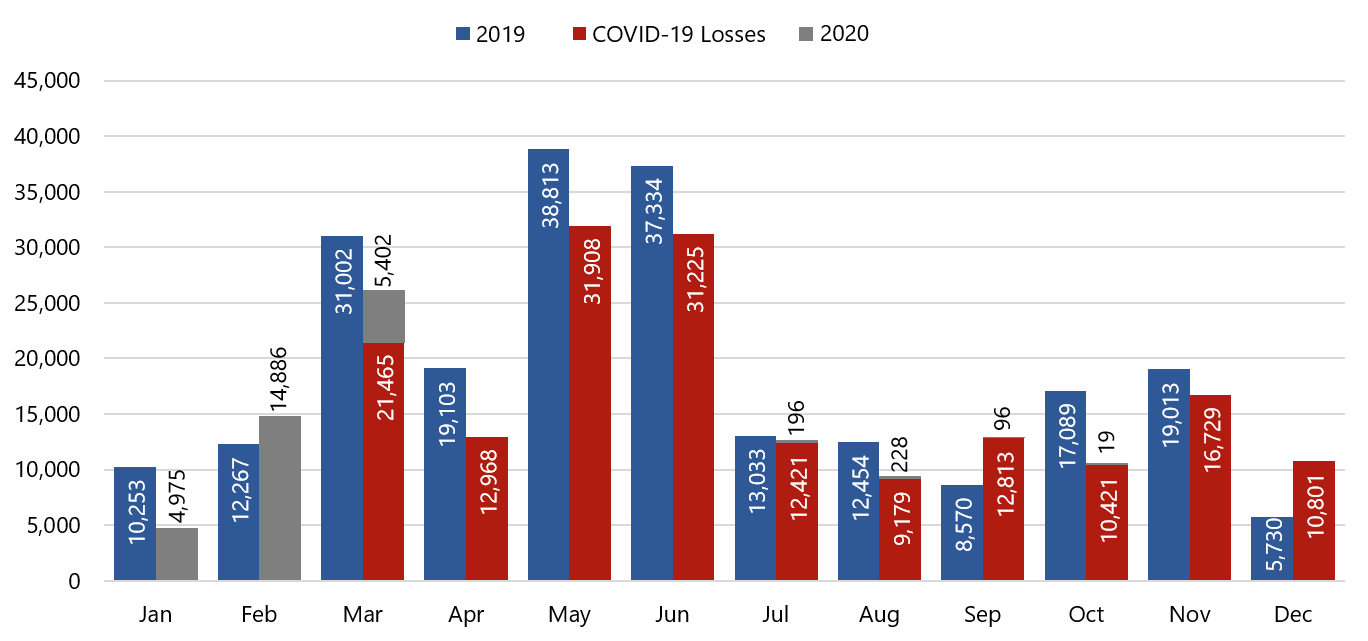
2019: Room nights that occurred or were set to occur in 2019 as of one year ago
2020: Room nights that occurred or were set to occur in 2020 as of the date above
COVID-19 Losses: Definite room nights and likely repeat sporting event room nights canceled or postponed due to the pandemic
Source: Visit Albuquerque
2020 Room Night Impact due to COVID-19 as of February 28, 2021
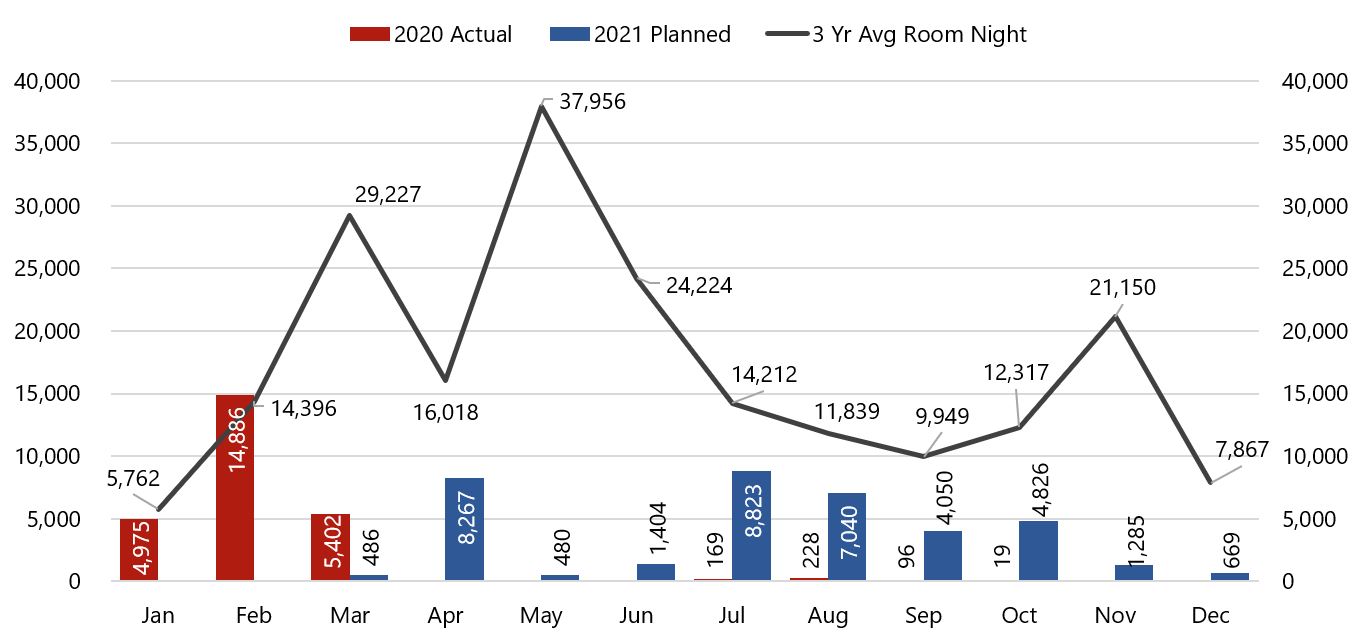
Legend:
3 Yr Average: Average monthly room nights that occurred during calendar years 2017-2019
2020: Room nights that occurred during calendar year 2020
2021: Room nights that occurred or are set to occur in 2021 as of the date above -- 2021 future events remain subject to cancellation
Source: Visit Albuquerque
- The outlook for events depends heavily on group restrictions during 2021, but many events were postponed to 2021, 2022, and 2023, with future bookings supporting a positive outlook, according to Visit Albuquerque officials.
- Similar to national trends, hotels within the full-service segment and the Downtown submarket were hit the hardest given the reliance on meeting and group demand, as well as commercial travelers. Extended-stay hotels have fared the best given the type of demand prevalent during the pandemic, as well as the occupancy-limit exemption for extended-stay guests.
- Travel to New Mexico primarily originates from drive-to destinations in surrounding states, including Texas, Colorado, California, and Arizona. Although additional demand comes from fly-to destinations such as Chicago, New York, Florida, and other domestic and international destinations, the influence of drive-to demand should support a quick recovery. Furthermore, as advertising outside the state of New Mexico resumes, momentum from the highly successful #NewMexicoTRUE platform is expected to be regained, raising the state’s recognition as a top travel destination in the Southwest.
- Limited new hotel supply is also expected to support the recovery going forward; furthermore, the additions to supply are anticipated to foster growth with their popularity among commercial travelers or tourists, such as the Los Poblanos: Historic Inn & Organic Farm.
New Mexico’s COVID-19 Guideline Highlights for Bernalillo County (as of April 7, 2021)
Hotel occupancy is limited to 60%, while vacation rentals are limited to five guests maximum.
New Mexico Safe Certified restaurants are limited to 33% indoor dining capacity, outdoor dining capacity is limited to 75%, and all establishments serving alcohol must close by 10 PM nightly. The capacity limits are lower for businesses without the certification.
Groups are limited to ten people or 80 vehicles. Other requirements as part of the current framework are listed here.
The phased framework is updated every two weeks here.
[1] Grace Reader, "UNMH moving forward with construction on parking structure; new tower expected to follow." 1/23/2021. Retrieved 4/7/2021.
[2] Village of Los Lunas – Minutes. 3/11/2021. Retrieved 4/7/2021.
[3] Chris Keller, Albuquerque Business First, "Here's what New Mexico officials and leaders have said about Netflix's planned expansion in Albuquerque." 11/23/2020. Retrieved 4/7/2021.
[4] Chris McKee, "Orion Center promises 1,000+ aerospace, manufacturing jobs for Albuquerque." 11/12/2020. Retrieved 4/7/2021.
[5] Resolutre listing. Retrieved 4/7/2021.
[6] Albuquerque International Balloon Fiesta, Inc., "Albuquerque International Balloon Fiesta Presented by Canon Generates $186.82 Million into Albuquerque Economy." 3/16/2020. Retrieved 4/9/2021.

0 Comments
Success
It will be displayed once approved by an administrator.
Thank you.
Error